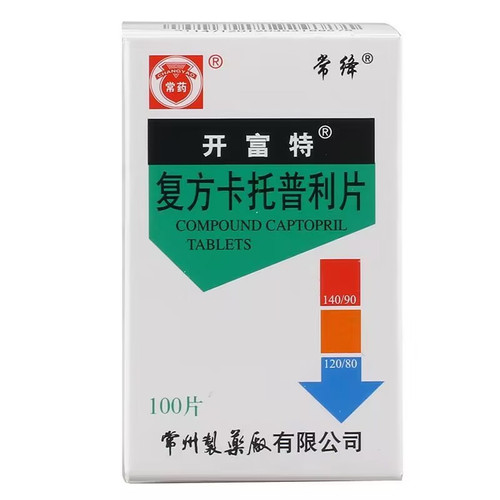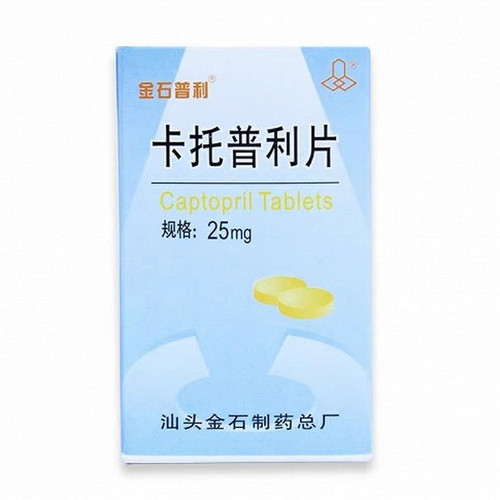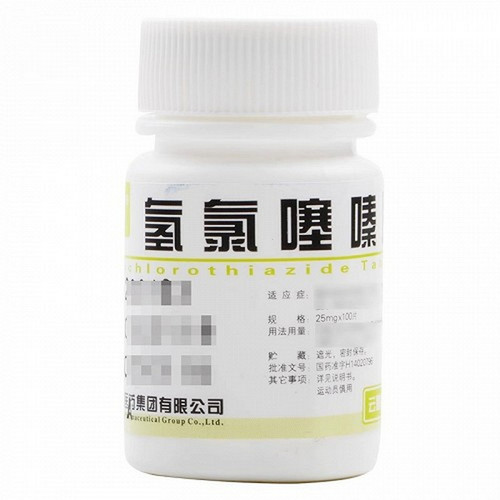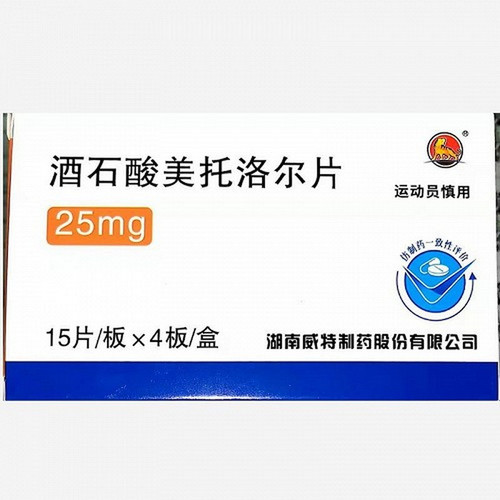Product Overview
[Drug Name]
Generic Name: Captopril Tablets
Trade Name: Common Medicine
English Name: Captopril Tablets
Chinese Pinyin: Katuopuli Pian
[Ingredients]
The main ingredient and its chemical name are: 1-[(2S)-2-methyl-3-mercapto-1-oxypropyl]-L-proline. Its structural formula is: Molecular formula: C9H15NO3S Molecular weight: 217.29
[Properties]
This product is a white or off-white crystalline powder with a distinctive garlic-like odor and a salty taste.
[Indications]
1. Hypertension; 2. Heart failure.
[Dosage and Administration]
Depends on the condition or individual differences. This product should be taken under the guidance or supervision of a physician. The dosage should be individualized and adjusted according to the therapeutic effect.
1. Common dosage for adults:
(1) For hypertension, take 12.5 mg orally once, 2-3 times a day. Increase to 50 mg 2-3 times a day within 1-2 weeks as needed. If the effect is still unsatisfactory, other antihypertensive drugs can be added.
(2) For heart failure, start with 12.5 mg orally once, 2-3 times a day. If necessary, gradually increase to 50 mg 2-3 times a day. If further increase is needed, observe the effect for 2 weeks before considering it. For patients who have recently taken a large amount of diuretics and are in hyponatremia/hypovolemia, but have normal or low blood pressure, the initial dose should be 6.25 mg 3 times a day. Then gradually increase to the common dosage after testing.
2. Common dosage for children to reduce blood pressure and treat heart failure, both start with 0.3 mg/kg of body weight, 3 times a day. If necessary, increase by 0.3 mg/kg every 8-24 hours to obtain the lowest effective dose.
[Adverse Reactions]
1. Common side effects include: (1) Rash, which may be accompanied by itching and fever. It often occurs within 4 weeks of treatment and is maculopapular or urticaria. It disappears after dose reduction, discontinuation of the drug or administration of antihistamines. 7% to 10% are accompanied by eosinophilia or positive antinuclear antibodies. (2) Palpitations, tachycardia, and chest pain. (3) Cough. (4) Taste loss.
2. Less common side effects include: (1) Proteinuria, which often occurs within 8 months of treatment. 1/4 of patients develop nephrotic syndrome, but proteinuria gradually decreases within 6 months and the course of treatment is not affected. (2) Dizziness, headache, and syncope. These are caused by hypotension, especially in the case of sodium deficiency or hypovolemia. (3) Angioedema, which occurs on the face and limbs. It can also cause angioedema of the tongue, glottis, or larynx. Patients should be vigilant.
[Contraindications]
This product is contraindicated in patients who are allergic to this product or other angiotensin-converting enzyme inhibitors.
[Precautions]
1. Food in the stomach can reduce the absorption of this product by 30-40%, so it is advisable to take the drug 1 hour before meals.
2. This product can increase the concentration of blood urea nitrogen and creatinine, which is often temporary. It is easy to occur after a rapid drop in blood pressure in patients with kidney disease or long-term severe hypertension. Occasionally, serum liver enzymes will increase. It may increase blood potassium. When used in combination with potassium-sparing diuretics, blood potassium should be checked carefully.
3. This product should be used with caution in the following situations: (1) Autoimmune diseases such as severe systemic lupus erythematosus, in which the chance of leukopenia or granulocytopenia increases. (2) Bone marrow suppression. (3) Insufficient blood supply to the cerebral artery or coronary artery, which may aggravate ischemia due to lowered blood pressure. (4) Hyperkalemia. (5) Renal dysfunction leading to increased blood potassium, leukopenia and granulocytopenia, and retention of this product. (6) Aortic valve stenosis, in which case coronary artery perfusion may be reduced. (7) Patients who strictly restrict sodium in their diet or undergo dialysis may experience sudden and severe hypotension after the first dose of this product.
4 Follow-up examinations during the use of this product: (1) White blood cell count and differential count, once every 2 weeks for the first 3 months, and then regularly thereafter, and immediately if there are signs of infection. (2) Urine protein test once a month.
5 Patients with poor renal function should use a small dose or reduce the number of doses, and increase the dose slowly; if diuretics must be used at the same time, furosemide is recommended instead of thiazides. When blood urea nitrogen and creatinine increase, reduce the dose of this product or stop the diuretic at the same time.
6 If proteinuria gradually increases while using this product, stop using this product or reduce the dosage.
7 If the white blood cell count is too low while using this product, stop using this product, and it may recover.
8 If angioedema occurs while using this product, stop using this product and quickly inject 0.30.5ml of 1:1000 epinephrine subcutaneously.
9 This product may cause a false positive urine acetone test.
[Use in Special Populations]
Precautions for Children:
This drug has been reported to cause an excessive and prolonged decrease in blood pressure, accompanied by oliguria and seizures, in infants. Therefore, its use is limited to those who have not responded to other antihypertensive treatments.
Precautions for Pregnancy and Lactation:
1. This drug crosses the placenta. 2. This drug is excreted in breast milk at concentrations approximately 1% of the maternal blood concentration. Therefore, use in lactating women must carefully weigh the risks and benefits. 3. ACEI absorption by pregnant women can affect fetal development and even cause fetal death. Therefore, it is contraindicated in pregnant women.
Precautions for Elderly:
The elderly are more sensitive to antihypertensive effects; therefore, the dose of this drug should be reduced as appropriate.
[Drug Interactions]
1. Concomitant use with diuretics enhances the antihypertensive effect. However, severe hypotension should be avoided. Therefore, patients currently taking diuretics should discontinue or reduce their dose. Initially use this drug at a low dose and gradually adjust the dose. 2. Concomitant use with other vasodilators may cause hypotension. If combined, start with a low dose. 3. Concomitant use with potassium-retaining drugs such as spironolactone, triamterene, and amiloride may cause hyperkalemia. 4. Concomitant use with endogenous prostaglandin synthesis inhibitors such as indomethacin will weaken the antihypertensive effect of this drug. 5. Concomitant use with other antihypertensive drugs may enhance the antihypertensive effect. Concomitant use with drugs that affect sympathetic nervous system activity (ganglionic or adrenergic blockers) and beta-blockers may enhance the antihypertensive effect and should be used with caution. 6. Concomitant use with lithium may increase serum lithium levels and lead to toxicity.
[Pharmacological Actions]
This drug is a competitive angiotensin-converting enzyme inhibitor, preventing the conversion of angiotensin I to angiotensin II, thereby reducing peripheral vascular resistance. It also reduces water and sodium retention by inhibiting aldosterone secretion. This drug can also dilate peripheral blood vessels by interfering with the degradation of bradykinin. In patients with heart failure, this drug can also reduce pulmonary capillary wedge pressure and pulmonary vascular resistance, increasing cardiac output and exercise tolerance time. [Storage] Store in a sealed, light-proof container.
[Strength] 25 mg
[Packaging] 25 mg x 100 s/box.
[Expiry Date] 24 months.
[Approval Number] National Medicine Standard H32023731
[Manufacturer] Company Name: Changzhou Pharmaceutical Factory Co., Ltd.






